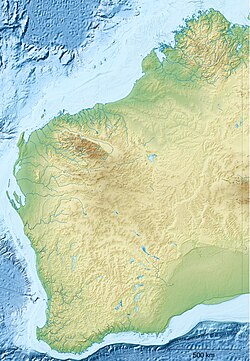Top Qs
Timeline
Chat
Perspective
Prince Regent National Park
Protected area in Western Australia From Wikipedia, the free encyclopedia
Remove ads
Prince Regent National Park, formerly the Prince Regent Nature Reserve, is a protected area in the Kimberley region of Western Australia. In 1978 the area was nominated as a UNESCO World Biosphere Reserve.
Remove ads
Remove ads
Land
Summarize
Perspective
The national park covers a total area of 5,764 square kilometres (2,225 sq mi)[1] and was created in 1964 to protect the catchment area of the Prince Regent River. The northern boundary of the national park abuts the southern boundary of the Mitchell River National Park creating a protected area of over 7,500 square kilometres (2,900 sq mi).[2] The landscape of the reserve ranges from lush rainforest to sandstone plains. The area contains gorges, waterfalls, cliffs and mountain ranges.
Careening Bay, on Coronation Island, site of "The Mermaid Tree" (after HMS Mermaid, Philip Parker King's ship) is within the park. The boab tree was inscribed by the ship's carpenter when the vessel was deliberately careened (beached) in order to undertake repairs.[3]
Traditional owners
The traditional owners of the area round the river are the Worrorra peoples,[4][5] but the park lies mainly in Wunambal land.[6]
As part of the same native title claim lodged in 1998 by Wanjina Wunggurr RNTBC known as the Dambimangari claim,[7] which included claims for the three peoples in the Wanjina Wunggurr cultural bloc, referred to as Dambimangari (Worrorra), Uunguu (Wunambal) and Wilinggin (Ngarinyin), the Uunguu parts of the claims were determined on 23 May 2011. This gave native title to the Wunambal people over 25,909 km2 (10,004 sq mi),[8][9] stretching along the coastal waters from the Anjo Peninsula in the north, including the waters of Admiralty Gulf and York Sound, down to Coronation Island. Inland, it includes parts of the Mitchell River National Park and the Prince Regent National Park.[10]
Remove ads
Wildlife
More than half of the bird and mammal species found in the Kimberley region are found within the national park.[11] It is home to the monjon, the smallest of the rock-wallabies,[12] and the golden bandicoot - listed as a vulnerable species.[13] The Prince Regent and Mitchell River Important Bird Area which overlaps part of the national park, is an area identified as an Important Bird Area by BirdLife International, an international non-government organisation, because of its importance for a range of bird species, especially those restricted to tropical savanna habitats.[14] Eighteen freshwater fish species are known to inhabit the waters of the Prince Regent River. Other species, like the monjon and saltwater crocodiles, also inhabit this area.
Remove ads
Crocodile attacks
- In 2015, a woman was attacked by a saltwater crocodile while swimming in a rockpool with a tour group.[citation needed]
Access
The area remains one of Australia's most remote wilderness areas with no roads and formidable tide-races and whirlpools restricting seaward access. The area is mostly accessed by air or by boat and has remained virtually unchanged since European settlement of Western Australia. A permit is required to enter the national park and can be obtained from the Parks and Wildlife Service.
See also
References
External links
Wikiwand - on
Seamless Wikipedia browsing. On steroids.
Remove ads



